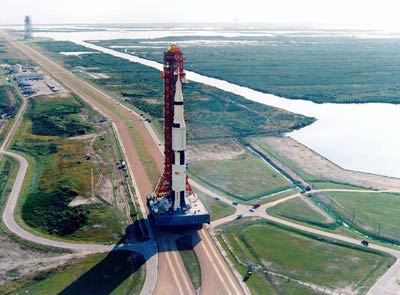When we stayed at home to leave EarthReview: “When We Left Earth: The NASA Missions”by Robert Pearlman
|
| “When We Left Earth” presents archival footage in new ways, both stylistically and visually, to mostly wonderful results. |
Discovery, at its own expense, remastered the audio and video from all the key on-boards filmed by the astronauts themselves, ultimately converting more than 100 hours of footage into high definition transfers. They then donated that treasure trove of material back to NASA for its own use and to share with future generations of scholars and filmmakers.
Meanwhile, Discovery took their own work and cut “When We Left Earth,” the first space exploration documentary to be broadcast in HD (the series simulcasts in standard definition, too).
The results are nothing short of spectacular. Last week, as astronauts Mike Fossum and Ron Garan made the 195th US extravehicular activity outside the space station, they marked the 43rd anniversary of the first US spacewalk by Gemini 4 astronaut Edward White. “When We Left Earth’s” second episode, “Friends and Rivals” includes the restored and upgraded footage shot of White during that June 3, 1965 EVA. It looks like it was shot by the same cameras used by Fossum and Garan.
Astronauts of all eras have said that their photography did not do justice to the bold colors and stark blackness of space. Now, as some have seen “When We Left Earth,” those opinions are changing.
“[It] captures what we see and what we felt and what we experienced, the reality, the vividness, the emotional side of it,” said Apollo 16 moonwalker Charlie Duke in reply to collectSPACE about the series.
“By making this high definition [transfer] of the films we did and the photographs that we took, it is going to be spectacular. People are going to awed,” described Duke.
A stellar cast
If “When We Left Earth” was only a skillfully edited series of NASA archival video clips, it would be worth watching, but what really makes it must-see-(HD)TV are the series of interview segments that are interspersed through each hour.
Set against a backdrop of stars, a parade of astronauts, flight controllers, family members, and more comment on the milestone flights on which they flew or were involved. In just the second-hour, 11 historic figures appear, eight being Gemini astronauts (half of the total who flew during the two-seater spacecraft program).
But it isn’t just the number that matters, it is the names.
Not that the likes of Duke, Buzz Aldrin or Chris Kraft can be dismissed as the “usual suspects” for such programs (if they are, it is because they are great story tellers) but “When We Left Earth” reaches beyond those seen in prior documentaries.
Flight directors Chris Kraft and Gene Kranz (of “Failure is not an option” fame) is joined by their lesser-known peer Glynn Lunney. Marilyn Lovell and Susan Borman, wives of astronauts Jim and Frank, are interviewed. And on the subject of space explorers, the likes of Jim McDivitt and Bill Anders make rare on-camera cameos.
And then there is Neil Armstrong.
Contrary to urban legend, Armstrong is not reclusive. He lectures several times a year and he recently authorized his biography to be published (which is now optioned for a major motion picture). That aside, the number of times he has agreed to a one-on-one media appearance over the 40 years since his moon landing could be counted on one hand.
If a picture is a worth a thousand words, then the words shared by Armstrong, Lovell, and others are well matched to the high-definition imagery.
Staying home to leave Earth
The six episodes of “When We Left Earth” document the United States’ crewed space flights over the past five decades. Two hours are devoted to Mercury and Gemini, followed by two covering the Apollo program and its spinoffs, Skylab and the Apollo-Soyuz Test Project. The final installments bring us current with the space shuttle and its missions to service the Hubble Space Telescope and assemble the International Space Station.
| If a picture is a worth a thousand words, then the words shared by Armstrong, Lovell, and others are well matched to the high-definition imagery. |
Narrated by Gary Sinise (“Apollo 13”, “Mission to Mars”, “CSI: NY”), the tone of the episodes can sometimes lean toward the dramatic, emphasizing the risks rather than how smoothly some of the key mission milestones really were. The series also glides (if not altogether skips) over certain missions, either for the lack of interviewees or the constraints of time. These slight drawbacks however, are only noticeable if you are already familiar with the history.
Even if you were one of the hundreds of thousands who made the history on screen possible, or have seen every hour of the “unseen” footage, there are ample reasons to not miss watching Discovery’s “When We Left Earth: The NASA Missions” Indeed, you’ll find yourself not wanting to leave the TV, let alone the planet.
